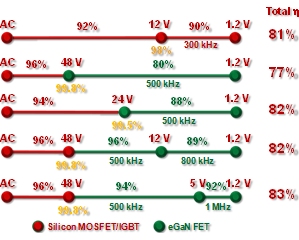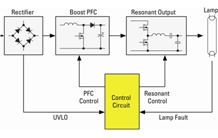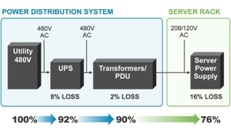HOW2POWER TODAY |
 |
|
ISSUE: September 2011 | |
To ensure receipt of your newsletter, please add david@how2power.com to your address book. | |
 |
IN THIS ISSUE:
» From the Editor’s Desk
» How2 Get From AC To Below 1 V With eGaN FETs
» Current-Loop Control In Switching Converters
Part 1: Historical Overview
» Circuit Implements Low-Cost Ballast Control
With High Power Factor
» Powering The Digital Media World:
Will High-Voltage AC Power Prevail in Quest
For Data Center Efficiency?
» New Power Products:
Power MOSFETs , IGBTs, And Modules
» Other Power News
From the Editor's Desk David G. Morrison
Editor, How2Power TODAY
|
|
 This issue marks the two-year anniversary of How2Power Today. If you enjoy reading this newsletter, please share the articles you find here with your colleagues and friends. Or take time to share your thoughts on a particular article with me. Your input can help to ensure the relevance and usefulness of future articles. This newsletter aims to explore power converter design across a range of applications and power levels, with articles written for various levels of interest and expertise. So for example, in this issue, part one of an extended article series on modeling of current-loop control may be intriguing to those designers seeking in-depth understanding of power converter design and operation. Another contributed article presents a straightforward application-oriented design solution based on a new ballast controller IC. Meanwhile, a third design article explores the efficiency-boosting changes in power system architecture that are made possible by GaN transistors. The theme of more-efficient architectures is taken to another realm in Ashok Bindra’s column on high-voltage ac power distribution in data centers. And for those interested in the latest advances in power semiconductors, a Product Roundup presents news of the latest power MOSFETs, IGBTs, and modules. Though each article represents a different perspective on how to address various challenges in power conversion, and some articles may be more relevant to your work than others, it is hoped that you’ll find something intriguing and thought provoking in this and every issue. This issue marks the two-year anniversary of How2Power Today. If you enjoy reading this newsletter, please share the articles you find here with your colleagues and friends. Or take time to share your thoughts on a particular article with me. Your input can help to ensure the relevance and usefulness of future articles. This newsletter aims to explore power converter design across a range of applications and power levels, with articles written for various levels of interest and expertise. So for example, in this issue, part one of an extended article series on modeling of current-loop control may be intriguing to those designers seeking in-depth understanding of power converter design and operation. Another contributed article presents a straightforward application-oriented design solution based on a new ballast controller IC. Meanwhile, a third design article explores the efficiency-boosting changes in power system architecture that are made possible by GaN transistors. The theme of more-efficient architectures is taken to another realm in Ashok Bindra’s column on high-voltage ac power distribution in data centers. And for those interested in the latest advances in power semiconductors, a Product Roundup presents news of the latest power MOSFETs, IGBTs, and modules. Though each article represents a different perspective on how to address various challenges in power conversion, and some articles may be more relevant to your work than others, it is hoped that you’ll find something intriguing and thought provoking in this and every issue.
|

HOW2POWER EXCLUSIVE DESIGN ARTICLES 
|

How2 Get From AC To Below 1 V With eGaN FETs
by Johan Strydom, Efficient Power Conversion, El Segundo, Calif.
A common challenge in power management for the computing industry is how to most efficiently convert ac line voltage to the approximately 1.2 V dc consumed by high-performance digital processors and peripherals. Today, the most common approach is to first convert the ac line voltage directly to a 12-V dc power distribution bus in one isolated power supply, and subsequently convert 12 V dc down to about 1.2 V dc in a second, nonisolated stage. Multiplying the efficiencies of these two stages and adding the distribution losses typically results in a total system conversion efficiency of approximately 81%. This value degrades further when the IC supply voltage drops below 1 V. This article examines options for improving this efficiency using the latest generation of enhancement-mode gallium nitride (eGaN) FETs. Read the full story…
| 
Stepping down 48 V to chip-level supply voltages in two stages
using eGaN FETs boosts overall system conversion efficiency,
while allowing higher switching frequencies. |


A small-signal model of the current loop in a
current-mode controlled power converter. |
Current-Loop Control In Switching Converters
Part 1: Historical Overview
by Dennis Feucht, Innovatia Laboratories, Cayo, Belize
Peak or valley current control of switching converters is well established in engineering practice. Yet the irony of current-loop control is that, after decades, its theory is still undergoing refinement. This is the result, in part, of the complexity of the seemingly simple current-loop controller circuit. Its typical circuit diagram has few parts, yet the current-feedback loop is nonlinear and switched, having discrete-time behavior. This series of articles reviews current-loop control history, clarifies established concepts, presents some problems with the existing theories or models of the current-control loop, and then offers what might be the first truly unified model of current control. Read the full story… |

Circuit Implements Low-Cost Ballast Control With High Power Factor
by Tom Ribarich, International Rectifier, El Segundo, Calif.
Fluorescent lamps continue to offer a high efficacy, long lifetime and low cost. T5 fluorescent lamps typically have high working voltages and are driven by an electronic ballast that is used to preheat the lamp filaments, ignite the lamp, and provide a high-frequency ac lamp running current. Adding power factor correction (PFC) to the electronic ballast is a requirement at higher power levels and enables the ballast to work like a “resistive” load on the ac mains. This article describes a novel circuit used to control an entire electronic ballast that includes active PFC as well as complete fluorescent lamp control. This article introduces the designer to the main circuit blocks of an electronic ballast, presents the new circuit control methods, and provides the complete electronic ballast circuit schematic for driving two 54-W T5 lamps. Experimental results are also shown. Read the full story… |

A novel circuit controls an entire electronic ballast
that includes active PFC as well as complete
fluorescent lamp control. |

 |  |

POWERING THE DIGITAL MEDIA WORLD 
A monthly column sponsored by Integrated Device Technology |

Will High-Voltage AC Power Prevail in Quest For Data Center Efficiency?
by Ashok Bindra, Technology Writer, Technika
In this column, Bindra continues his look at ac versus dc power distribution in the data center, examining the work being done by proponents of high-voltage ac power distribution. He discusses Facebook’s Open Compute Project, which concerns a data center design that brings 480-V/277-V ac direct to the server power supply; Eaton’s development of 480-V ac power distribution units; and a 400-V ac power distribution model that’s caught on in Europe, Asia, and South America. Bindra looks at the efficiency improvements made possible by these developments, as well as other considerations that have been identified by related studies. Read the full story…
|

End-to-end efficiency for a traditional 480/208-V ac
power distribution system is about 76%, but can
be improved through the use of high-efficiency
277-V server power supplies. |

 |
 |
 — POWER PRODUCTS IN 3 IMAGES OR LESS — POWER PRODUCTS IN 3 IMAGES OR LESS 
|

OTHER TOP POWER NEWS |

PhD/Industrial Courses
This fall, Aalborg University will hold three PhD/Industrial courses: "Power Electronics for Renewable Energy Systems—in theory and practice," October4 - 6; "Photovoltaics Power Systems—in theory and practice," October10 - 13; "MicroGrids—in theory and practice," October31 - November 2. For more details… |
PEMD 2012
On September 21, 2011, PEMD 2012: International Conference on Power Electronics, Machines and Drives will be held March 27-29, 2012 at the University of Bristol, UK. For more details… |
New Listings In Consultants Corner
How2Power’s Consultants Corner directory of power electronics consultants continues to grow. You can now read about the specialized services offered by ADX Research, Bose Research, Design Automation, dtm Associates, and Wegatech Electronic. For more details… |


|

 |
|

 |
 |

ABOUT THIS NEWSLETTER: Thank you for reading HOW2POWER TODAY.
How2Power sends no more than one e-mail per month to registered users. Continuing your subscription ensures you'll receive future newsletters. Manage Your Subscription
©2011 All rights reserved. www.how2power.com
|